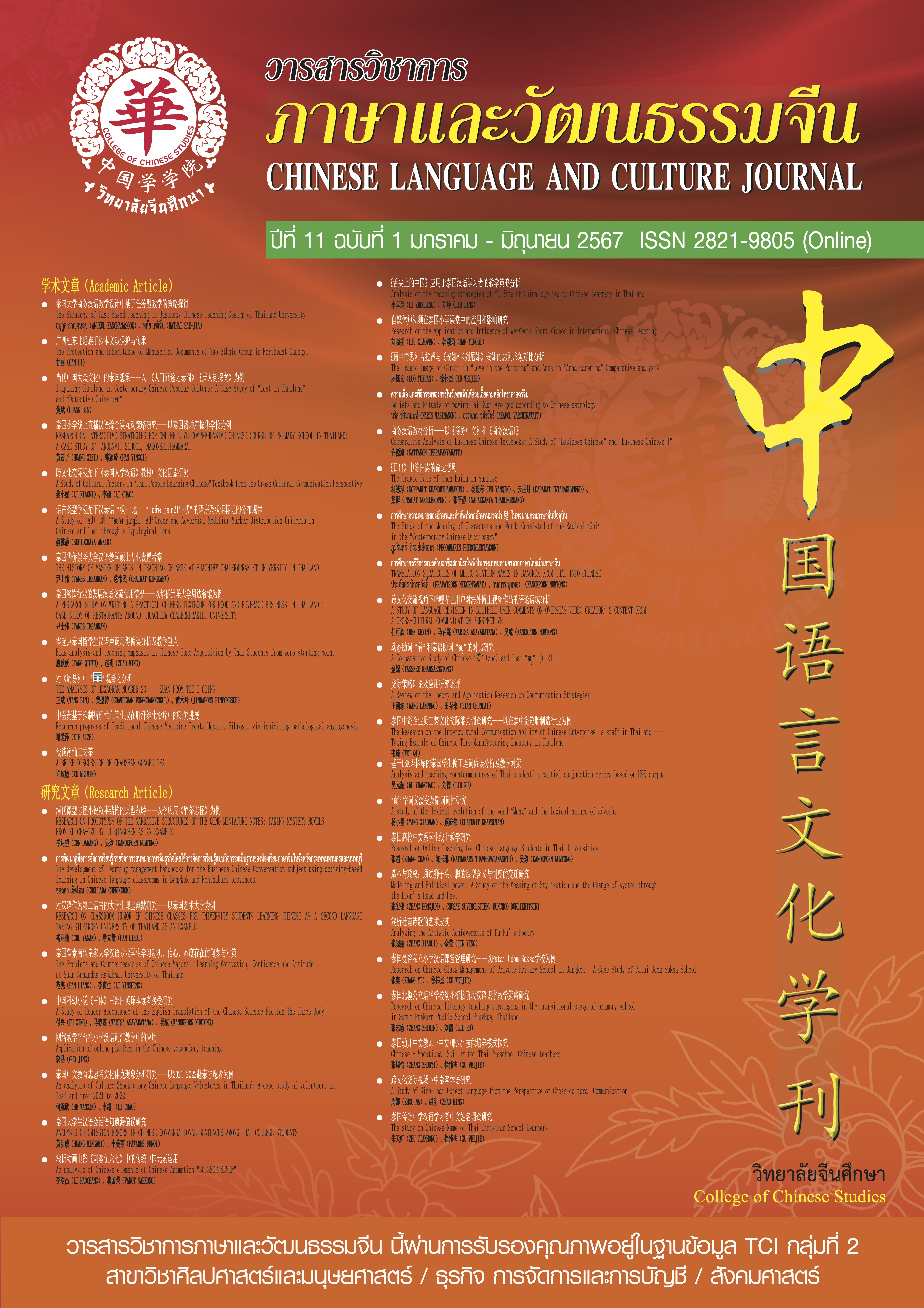ANALYSIS OF OMISSION ERRORS IN CHINESE CONVERSATIONAL SENTENCES AMONG THAI COLLEGE STUDENTS
Keywords:
Thai students, Spoken Chinese,, Omission errors, Teaching suggestionsAbstract
This study utilizes a theoretical framework of second language acquisition and error analysis to investigate 1,500 spoken Chinese sentences from the assignments of 79 Thai sophomore students. The errors can be broadly classified into seven categories: omissions, redundancies, unsuitable vocabulary, inappropriate punctuation, typos, word order, and mixtures. This study focuses on the categorization and examination of errors that occur due to omissions.
The omissions referred to in this study are errors caused by the omission of “sentence components” and “sentence expressions” in students’ spoken sentences. The research results show that the former includes nouns, pronouns, verbs, adjectives, adverbs, auxiliary words, conjunctions, prepositions, numerals, quantifiers, and affixes, etc., while the latter mainly refers to punctuation, with a total of 12 situations. The study attributes these errors to the students’ proficiency in Chinese grammar, their capacity to adapt to spoken communication, and their shortcomings in comprehending and articulating specific topics. These errors can also be caused by other reasons such as performance anxiety, lack of experience with spoken Chinese, and insufficient understanding of the communication environment. According to the analysis provided, the study presents six instructional suggestions aimed at assisting students in overcoming these prevalent errors and enhancing their skills in spoken Chinese. This paper has significant consequences for comprehending the omissions made by Thai students in their spoken Chinese communication and for offering teachers useful guidance in teaching.
References
陈晨.泰国学生汉语趋向补语习得偏误分析.[D].昆明:云南师范大学,2005.
戴炜栋、束定芳.对比分析、错误分析和中介语研究中的若干问题一一外语教学理论研究之二.[J].
外国语(上海外国语大学学报),1994:1-7.
冯贝贝.泰国学生重复义副词“还”、“再”、“又”、“也”的偏误分析.[D].郑州:郑州大学,2019.
广州外国语言学院.泰汉词典.[M].曼谷:泰国南美有限公司,1987.
侯丽杰.汉语中委婉表达方式新探.[J].沈阳教育学院学报,2000,(01):43-47.
黄鸿.泰国学生习得对外汉语方位词偏误分析——以甲级词汇大纲为例.[D].长沙:湖南师范大学,2013.
李红印.泰国学生汉语学习的语音偏误.[J].世界汉语教学,1995,(2):66-71.
李慧敏.泰国高中生初级汉语教学常见的语法偏误研究--以泰国帕府娜丽拉中学高中学生为例.[J].Graduate School Journal,2015,(8):123-131.
李丽美.泰国学生学习汉语名量词的四种语法偏误分析.[J].Liberal Arts Review,2017,(23):97–104.
李泉.中国对外汉语教学七十年.[J].语言战略研究,2019,(4):49-59.
林勇明.泰国学生汉语定语顺序的偏误分析及其习得顺序.[D].北京:北京语言文化大学,2000.
刘丹.泰国学生“有”字句偏误研究.[D].长沙:湖南大学,2017.
刘苏.泰国学生汉语语气词“吧”的习得及教学研究.[D].武汉:华中师范大学大学,2018.
刘曦.对泰汉语应用文写作课常见问题及改进策略研究——以泰国华侨崇圣大学,商会大学等为案例.[D].桂林:广西大学,2013.
鲁健骥.中介语理论与外国人学习汉语的语音偏误分析.[J].语言教学与研究,1984,(3):44-56.
鲁健骥.偏误分析与对外汉语教学.[J].语言文字应用,1992,(01): 69-73.
鲁健骥.外国人学汉语的语法偏误分析.[J].语言教学与研究,1994,(01): 49-64.
罗洪清.泰国学生汉语给予类动词“发、送、交、寄”偏误研究.[D].武汉:华中师范大学,2021.
罗晓杰、孙琳.偏误理论与二语习得.[J].外语学刊,2003,(2):103-105.
吕叔湘.现代汉语八百词(增订本).[M].北京:商务印书馆,2007.
孙德坤.中介语理论与汉语习得研究.[J].语言文字应用,1993,(4):82-92.
徐妙珍.汉泰语临时名量词对比与教学研究.[D].重庆:西南大学,2010.
杨汉川.现代汉泰词典.[M].融三(1977)有限公司,2008.
杨婷伟.泰国学生习得“是……的”句偏误分析及教学对策.[D].辽宁:辽宁师范大学,2021.
叶含香.汉泰方位词比较研究.汉泰方位词比较研究.[D].武汉:华中师范大学,2018.
尹若男.泰国大学中文系学生“把”字句回避现象调查研究——以宋卡王子大学等三所大学为例.[D].广西:广西师范大学,2022.
中国社会科学院语言研究所词典编辑室.现代汉语词典(第7版).[Z].北京:商务印书馆,2016.
周小兵.对外汉语教学入门.[M].广州:中山大学出版社,2015:302.[29] 朱德熙.语法讲义.[M].北京:商务印书馆,2015.
朱其智、周小兵.语法偏误类别的考察.[J].语言文字应用,2007,(1):111-118.
Brown,H.D. Principles of Language Learning and Teaching.[M].New Jersey:Prentice Hall,1980.
Corder,S.P.Idiosyncratic Dialects and Error Analysis.[J].International Review of Applied Linguistics,1971,(2):19-159.
Dulay, H.C.Burt, M.K.and Kreshen,S. Language two.[M].New York,NY:Oxford University Press,1982.
Downloads
Published
How to Cite
Issue
Section
License
Copyright (c) 2024 Chinese Language and Culture Journal

This work is licensed under a Creative Commons Attribution-NonCommercial-NoDerivatives 4.0 International License.
บทความที่ได้รับการตีพิมพ์เป็นลิขสิทธิ์ของวารสารภาษาและวัฒนธรรมจีน มหาวิทยาลัยหัวเฉียวเฉลิมพระเกียรติ
บทความใน “วารสารวิชาการภาษาและวัฒนธรรมจีน” เป็นทรรศนะของผู้เขียนโดยเฉพาะ กองบรรณาธิการไม่มีส่วนในความคิดเห็นในข้อเขียนเหล่านั้น




